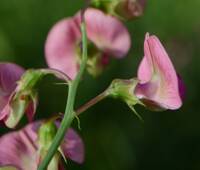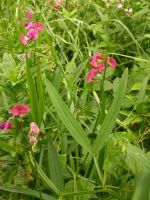Distribution: Occurring chiefly west of the Cascades in Washington; British Columbia to Oregon, east to the Rocky Mountains, also in eastern North America
Habitat: Roadsides and waste places at low elevations.
Flowers: May-July
Origin: Introduced from Europe
Growth Duration: Perennial
Conservation Status: Not of concern
Pollination: Bumblebees, bees, butterflies
Glabrous, herbaceous perennial from rhizomes, the stem 6-20 dm. long, broadly winged and climbing.
Leaves pinnate, leaflets only 2, lanceolate to lance-elliptic, 5-12 cm. long; tendrils well-developed; stipules linear-lanceolate, 2-lobed, 1-3 cm. long.
Inflorescence of racemes on long peduncles arising from the leaf axils; flowers 4-9, about 15 mm. long, red; calyx 7-9 mm. long, the 5 teeth lanceolate, shorter than the tube; corolla pea-like, banner broadly obcordate, the claw shorter than blade; wings and keel with a claw about half the length of the blade
Pod 4-6 cm. long and 4-6 mm. broad.
Publication: Sp. Pl. 2: 733. 1753. 1753.
PNW Herbaria: Specimen records of Lathyrus sylvestris in the Consortium of Pacific Northwest Herbaria database
WA Flora Checklist: Lathyrus sylvestris checklist entry
OregonFlora: Lathyrus sylvestris information
E-Flora BC: Lathyrus sylvestris atlas page
CalPhotos: Lathyrus sylvestris photos
























